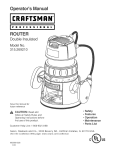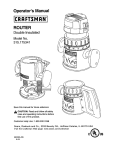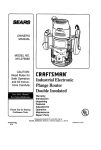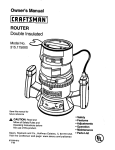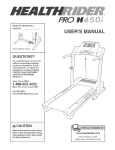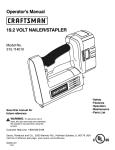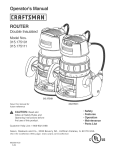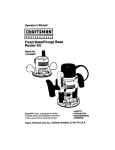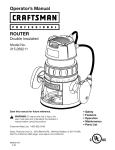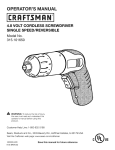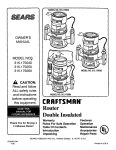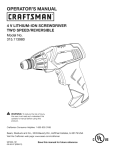Download Craftsman 315.175342 Operator`s manual
Transcript
PERATOR'S MANUAL T ® ROUTER DOUBLE iNSULATED Model No. 315.175342 0 A WARNING: To reduce the risk of injury, the user must read and understand the operator's manual before using this product. Customer Help Line: 1-800-932-3188 Sears, Roebuck and Co., 3333 Beverly Rd., Hoffman Visit the Craftsman web page: www.sears.com/craftsman 983000-746 4-05 Save this manual Estates, IL 60179 USA for future reference [] Warranty .......................................................................................................................................................................... 2 [] Introduction ..................................................................................................................................................................... 2 [] General Safety Rules .................................................................................................................................................... 3-4 [] Specific Safety Rules ....................................................................................................................................................... 4 [] Symbols ........................................................................................................................................................................ 5-6 [] Electrical .......................................................................................................................................................................... 7 [] Features ........................................................................................................................................................................... 8 [] Assembly ......................................................................................................................................................................... 9 [] Operation .................................................................................................................................................................... 9-18 [] Maintenance .................................................................................................................................................................. 19 [] Accessories ................................................................................................................................................................... 20 [] Exploded View and Parts List ........................................................................................................................................ 21 [] Parts Ordering/Service ..................................................................................................................................... FULL ONE YEAR WARRANTY ON CRAFTSMAN Back Page TOOL If this CRAFTSMAN tool fails to give complete satisfaction within one year from the date of purchase, RETURN IT TO THE NEAREST SEARS STORE OR SEARS SERVICE CENTER IN THE UNITED STATES, and Sears will repair it, free of charge. If this CRAFTSMAN of purchase. tool is used for commercial or rental purposes, this warranty applies for only 90 days from the date This warranty gives you specific legal rights, and you may also have other rights which vary from state to state. Sears, Roebuck and Co., Dept. 817WA, Hoffman Estates, IL 60179 This tool has many features for making its use more pleasant and enjoyable. Safety, performance, have been given top priority in the design of this product making it easy to maintain and operate. and dependability A WARNING: Read and understand all instructions. Failure to follow all instructions listed below, may result in electric shock, fire and/or serious personal injury. SAVE THESE WORK INSTRUCTIONS AREA [] Keep your work area clean and well lit. Cluttered benches and dark areas invite accidents. [] Do not operate power tools in explosive atmospheres, such as in the presence of flammable liquids, gases, or dust. Power tools create sparks which may ignite the dust or fumes. [] Keep bystanders, children, and visitors away while operating a power tool. Distractions can cause you to lose control. ELECTRICAL SAFETY [] Double insulated tools are equipped with a polarized plug (one blade is wider than the other). This plug will fit in a polarized outlet only one way. If the plug does not fit fully in the outlet, reverse the plug. If it still does not fit, contact a qualified electrician to install a polarized outlet. Do not change the plug in any way. Double insulation [] eliminates the need for the three-wire grounded power cord and grounded power supply system. [] Avoid body contact with grounded surfaces such as pipes, radiators, ranges, and refrigerators. There is an increased risk of electric shock if your body is grounded. [] Don't expose power tools to rain or wet conditions. Water entering a power tool will increase the risk of electric shock. [] Do not abuse the cord. Never use the cord to carry the tools or pull the plug from an outlet. Keep cord away from heat, oil, sharp edges, or moving parts. Replace damaged cords immediately. Damaged cords increase the risk of electric shock. [] When operating a power tool outside, use an outdoor extension cord marked "W=A" or "W". These cords are rated for outdoor use and reduce the risk of electric shock. PERSONAL SAFETY [] Stay alert, watch what you are doing and use common sense when operating a power tool. Do not use tool while tired or under the influence of drugs, alcohol, or medication. A moment of inattention while operating power tools may result in serious personal injury. [] Dress properly. Do not wear loose clothing or jewelry. Contain long hair. Keep your hair, clothing, and gloves away from moving parts. Loose clothes, jewelry, or long hair can be caught in moving parts. [] Avoid accidental starting. Be sure switch is off before plugging in. Carrying tools with your finger on the switch or plugging in tools that have the switch on invites accidents. [] Remove adjusting keys or wrenches before turning the tool on. A wrench or a key that is left attached to a rotating part of the tool may result in personal injury. [] Do not overreach. Keep proper footing and balance at all times. Proper footing and balance enables better control of the tool in unexpected situations. [] Use safety equipment. Always wear eye protection. Dust mask, nonskid safety shoes, hard hat, or hearing protection must be used for appropriate conditions. [] Do not wear loose clothing or jewelry. Contain long hair. Loose clothes, jewelry, or long hair can be drawn into air vents. [] Do not use on a ladder or unstable support. Stable footing on a solid surface enables better control of the tool in unexpected situations. TOOL USE AND CARE [] Use clamps or other practical way to secure and support the workpiece to a stable platform. Holding the work by hand or against your body is unstable and may lead to loss of control. [] Do not force tool. Use the correct tool for your application. The correct tool will do the job better and safer at the rate for which it is designed. [] Do not use tool if switch does not turn it on or off. Any tool that cannot be controlled with the switch is dangerous and must be repaired. [] Disconnect the plug from power source before making any adjustments, changing accessories, or storing the tool. Such preventive safety measures reduce the risk of starting the tool accidentally. [] Store idle tools out of the reach of children and other untrained persons. Tools are dangerous in the hands of untrained users. [] Maintain tools with care. Keep cutting tools sharp and clean. Properly maintained tools with sharp cutting edges are less likely to bind and are easier to control. [] Check for misalignment or binding of moving parts, breakage of parts, and any other condition that may affect the tool's operation, if damaged, have the tool serviced before using. Many accidents are caused by poorly maintained tools. [] Use only accessories that are recommended by the manufacturer for your model. Accessories that may be suitable for one tool, may become hazardous when used on another tool. [] Keep the tool and its handle dry, clean and free from oil and grease. Always use a clean cloth when cleaning. Never use brake fluids, gasoline, petroleumbased products, or any strong solvents to clean your tool. Following this rule will reduce the risk of loss of control and deterioration of the enclosure plastic. SERVICE [] Tool service must be performed only by qualified repair personnel. Service or maintenance performed by unqualified personnel may result in a risk of injury. [] Hold tool by insulated gripping surfaces when performing an operation where the cutting tool may contact hidden wiring or its own cord. Contact with a "live" wire will make exposed metal parts of the cutting tool "live" and shock the operator. [] Know your power tool. Read operator's manual carefully. Learn its applications and limitations, as well as the specific potential hazards related to this tool. Following this rule will reduce the risk of electric shock, fire, or serious injury. [] Always wear safety glasses. Everyday eyeglasses have only impact-resistant lenses; they are NOT safety glasses. Following this rule will reduce the risk of serious personal injury. [] Protect your lungs. Wear a face or dust mask if the operation is dusty. Following this rule will reduce the risk of serious personal injury. [] Protect your hearing. Wear hearing protection during extended periods of operation. Following this rule will reduce the risk of serious personal injury. [] Inspect tool cords periodically and, if damaged, have repaired at your nearest Authorized Service Center. Constantly stay aware of cord location. Following this rule will reduce the risk of electric shock or fire. [] When servicing a tool, use only identical replacemerit parts. Follow instructions in the Maintenance section of this manual. Use of unauthorized parts or failure to follow Maintenance Instructions may create a risk of shock or injury. be carefully checked to determine that it will operate properly and perform its intended function. Check for alignment of moving parts, binding of moving parts, breakage of parts, mounting, and any other conditions that may affect its operation. A guard or other part that is damaged should be properly repaired or replaced by an authorized service center. Following this rule will reduce the risk of shock, fire, or serious injury. [] Make sure your extension cord is in good condition. When using an extension cord, be sure to use one heavy enough to carry the current your product will draw. A wire gauge size (A.W.G.) of at least 14 is recommended for an extension cord 50 feet or less in length. A cord exceeding 100 feet is not recommended. If in doubt, use the next heavier gauge. The smaller the gauge number, the heavier the cord. An undersized cord will cause a drop in line voltage resulting in loss of power and overheating. [] Inspect for and remove all nails from lumber before using this tool. Following this rule will reduce the risk of serious personal injury. [] Save these instructions. Refer to them frequently and use them to instruct others who may use this tool. If you loan someone this tool, loan them these instructions also. [] Check damaged parts. Before further use of the tool, a guard or other part that is damaged should _1_ WARNING: Some dust created by power sanding, sawing, grinding, drilling, and other construction contains chemicals known to cause cancer, birth defects or other reproductive chemicals are: • lead from lead-based paints, activities harm. Some examples of these crystalline silica from bricks and cement and other masonry products, and arsenic and chromium from chemically-treated lumber. Your risk from these exposures varies, depending on how often you do this type of work. To reduce your exposure to these chemicals: work in a well ventilated area, and work with approved safety equipment, such as those dust masks that are specially designed to filter out microscopic particles. Someofthefollowingsymbolsmaybeusedonthistool.Pleasestudythemandlearntheirmeaning.Properinterpretationofthesesymbolswillallowyouto operatethetoolbetterandsafer. SYMBOL NAME DESIGNATION/EXPLANATION V Volts Voltage A Am pe res Current Hz Hertz Frequency (cycles per second) W Watt Power Minutes Time Alternating Current Type of current Direct Current Type or a characteristic no No Load Speed Rotational speed, at no load [] Class II Construction Double-insulated .../min Per Minute Revolutions, strokes, surface speed, orbits etc., per minute @ Wet Conditions Alert Do not expose to rain or use in damp locations. Read The Operator's Manual To reduce the risk of injury, user must read and understand operator's manual before using this product. Eye Protection Always wear safety goggles, safety glasses with side shields, or a full face shield when operating this product. Safety Alert Precautions that involve your safety. No Hands Symbol Failure to keep your hands away from the blade will result in serious personal injury. No Hands Symbol Failure to keep your hands away from the blade will result in serious personal injury. No Hands Symbol Failure to keep your hands away from the blade will result in serious personal injury. No Hands Symbol Failure to keep your hands away from the blade will result in serious personal injury. Hot Surface To reduce the risk of injury or damage, avoid contact with any hot surface. min 0 @ @ @ ® of current construction Thefollowingsignalwordsandmeanings areintendedto explainthe levelsofriskassociated withthis product. SYMBOL SIGNAL MEANING DANGER: Indicates an imminently hazardous situation, which, if not avoided, will result in death or serious injury. WARNING: Indicates a potentially hazardous situation, which, if not avoided, could result in death or serious injury. CAUTION: Indicates a potentially hazardous result in minor or moderate injury. situation, which, if not avoided, may CAUTION: (Without Safety Alert Symbol) Indicates a situation that may result in property damage. SERVICE Servicing requires extreme care and knowledge and should be performed only by a qualified service technician. For service we suggest you return the product to your nearest AUTHORIZED SERVICE CENTER for repair. When servicing, use only identical replacement parts. ,_ A WARNING; To avoid serious personal injury, do not attempt to use this product until you read thoroughly and understand completely the operator's manual. Save this operator's manual and review frequently for continuing safe operation and instructing others who may use this product. WARNING" The operation of any power tool can result in foreign objects being thrown into your eyes, which can result in severe eye damage. Before beginning power tool operation, always wear safety goggles, safety glasses with side shields, or a full face shield when needed. We recommend Wide Vision Safety Mask for use over eyeglasses or standard safety glasses with side shields. Always use eye protection which is marked to comply with ANSI Z87.1. SAVE THESE INSTRUCTIONS DOUBLE INSULATION Double insulation is a concept in safety in electric power tools, which eliminates the need for the usual three-wire grounded power cord. All exposed metal parts are isolated from the internal metal motor components with protecting insulation. Double insulated tools do not need to be grounded. A WARNING: The double insulated system is intended to protect the user from shock resulting from a break in the tool's internal insulation. Observe all normal safety precautions to avoid electrical shock. NOTE: Servicing of a tool with double insulation requires extreme care and knowledge of the system and should be performed only by a qualified service technician. For service, we suggest you return the tool to your nearest authorized service center for repair. Always use original factory replacement parts when servicing. ELECTRICAL CONNECTION This tool has a precision-built electric motor. It should be connected to a power supply that is 120 volts, 60 Hz, AO only (normal household current}. Do not operate this tool on direct current (DC). A substantial voltage drop will cause a loss of power and the motor will overheat. If your tool does not operate when plugged into an outlet, double-check the power supply. EXTENSION CORDS When using a power tool at a considerable distance from a power source, be sure to use an extension cord that has the capacity to handle the current the tool will draw. An undersized cord will cause a drop in line voltage, resulting in overheating and loss of power. Use the chart to determine the minimum wire size required in an extension cord. Only round jacketed cords listed by Underwriter's Laboratories (UL) should be used. When working outdoors with a tool, use an extension cord that is designed for outside use. This type of cord is designated with "WA" on the cord's jacket. Before using any extension cord, inspect it for loose or exposed wires and cut or worn insulation. **Ampere rating (on tool faceplate) 0-2.0 2.1-3.4 3.5-5.0 5.1-7.0 7.1-12.0 12.1-16.0 Cord Length Wire Size (A.W.G.) 25' 16 16 16 16 14 14 50' 16 16 16 14 14 12 100' 16 16 14 12 10 -- **Used on 12 gauge - 20 amp circuit NOTE: AWG = American Wire Gauge A A WARNING: Keep the extension cord clear of the working area. Position the cord so that it will not get caught on lumber, tools or other obstructions while you are working with a power tool. Failure to do so can result in serious personal injury. WARNING: Check extension cords before each use. If damaged replace immediately. Never use tool with a damaged cord since touching the damaged area could cause electrical shock resulting in serious injury. PRODUCTSPECIFICATIONS ...................................................................... 2 DepthofCut............................................................ 1-1/2in. Horsepower NoLoadSpeed ............................................... 25,000/rain. Depthof Plunge ............................................................. 2 in. Collet.......................................................................... 1/4in. Input................................ 120V,60Hz,AConly9.5Amps NetWeight............................................................. 5.06Ibs. MOTOR HOUSING TOGGLE SWITCH SPINDLELOCK BUTTON Fig. 1 KNOW YOUR ROUTER SPINDLE See Figure 1, Before attempting to use this product, familiarize yourself with all operating features and safety rules. TOGGLE SWITCH The router has a conveniently located toggle switch. LOCK BUTTON The spindle lock secures the spindle while you make adjustments and acts as a retainer to keep the router body from coming out of the base. UNPACKING This product has been shipped completely assembled. [] Carefully remove the tool and any accessories from the box. Make sure that all items listed in the packing list are included. [] Inspect the tool carefully to make sure no breakage or damage occurred during shipping. ,_ A [] Do not discard the packing material until you have carefully inspected and satisfactorily operated the tool. [] If any parts are damaged or missing, please call 1-800-932-3188 for assistance. PACKING A LiST Router with Fixed Base Plunge Base Toolbag Dust Nozzle with Screws (#6-32 x 3/8 in.) Wrench Operator's Manual _11_ WARNING: Do not allow familiarity with tools to make you careless. Remember that a careless fraction of a second is sufficient to inflict serious injury. A A A A WARNING; If any parts are missing do not operate this tool until the missing parts are replaced. Failure to do so could result in possible serious personal injury. WARNING: Do not attempt to modify this tool or create accessories not recommended for use with this tool. Any such alteration or modification is misuse and could result in a hazardous condition leading to possible serious personal injury. WARNING: Do not connect to power supply until assembly is complete. Failure to comply could result in accidental starting and possible serious injury. WARNING: Never attempt to use the router motor without first installing it in one of the approved bases. Failure to heed this warning could result in personal injury and damage to the motor. WARNING; Always wear safety goggles or safety glasses with side shields when operating power tools. Failure to do so could result in objects being thrown into your eyes resulting in possible serious injury. SWITCHING BASE WARNING: Do not use any attachments or accessories not recommended by the manufacturer of this tool. The use of attachments or accessories not recommended can result in serious personal injury. [] Place the router upside down with the Craftsman label away from you. WARNING: Never attempt to use the router motor without first installing it in one of the approved bases. Failure to heed this warning could result in personal injury and damage to the motor. APPLICATIONS [] Rout grooves, carve designs, mortise door jambs, or create joints [] Cabinet making, routing counter tops, and finishing work FROM FIXED BASE TO PLUNGE See Figures 2 - 3, To remove the fixed base: [] Unplug the router. [] Loosen the locking arm on the base. [] Depress and hold the spindle lock button. The spindle lock button will not depress fully unless it is in line with the hole in the collet. [] If the spindle lock button does not depress fully, turn the collet nut while depressing the spindle lock button. As they align, the spindle lock button will depress fully. [] Turn the depth adjusting ring counterclockwise the motor is at its highest position. until [] Align the indicator arrow on the depth adjustment ring with the indicator point on the base. [] Pull the base until it dislodges from the motor housing. Use caution as this may result in permanent damage to the locking mechanism. Toinstallthe plungebase: [] Unplugthe router. [] Placetheplungebaseona fiatsurface. [] Loosenthelockingknob. [] Alignthegrooveinthe motorhousingwiththerib insidethe base. NOTE:Therib is locatedonthe insideof thebasein linewiththehandle. [] Depressandholdthespindlelockbutton. [] Slidethe motorhousingintothebase. [] Tightenthe lockingknob. GROOVE INMOTOR HOUSING LOCKING KNOB CAUTION:Donottightenthe lockingknobwithout the motorinstalledinthebase.Failureto heedthis warningcouldcauseseriousinjury. RiBINSIDE BASE Fig. 3 SWITCHING FROM PLUNGE BASE TO FIXED BASE SPINDLE LOCK BUTTON See Figures 4 - 6. To remove the plunge base: [] Unplug the router. [] Place the router on a fiat surface. ARM [] Loosen the locking knob. [] Depress and hold the spindle lock button. The spindle lock button will not depress fully unless it is in line with the hole in the collet. [] If the spindle lock button does not depress fully, turn the collet nut while depressing the spindle lock button. When aligned, the spindle lock button will depress fully. DEPTH ADJUSTMENT RING [] Remove the motor housing from the plunge base. INDICATOR ARROW _i_ NOTE: When removing the motor from the base, the spindle lock button must be depressed until it clears the opening beneath the base. DEPTH ADJUSTMENT RING INDICATORPOINT Fig. 2 10 TO INSTALL THE FIXED BASE See Figures 4 - 6, [] Unplug the router. [] Place the fixed base on a flat surface. [] Loosen the locking arm. [] Align the indicator arrow on the depth adjustment ring with the indicator point on the base. [] Align the groove in the motor housing with the tab inside of the base. NOTE: The tab is located on the inside of the base in line with the handle. [] Depress and hold the spindle lock button on the motor. [] Slide the motor housing into the base. TABiNSiDE BASE [] Turn the depth adjusting ring counterclockwise until the spindle lock snaps out as it clears the rear window, just below the locking arm. [] Tighten the locking arm. DEPTH ADJUSTMENT RING LOCKING KNOB Fig. 5 INDICATOR ARROW DEPTH ADJUSTMENT RING INDICATORPOINT Fig. 6 SPINDLELOCK BUTTON Fig. 4 11 A WARNING: If the collet nut is not securely tightened, the cutter may detach during use, causing serious personal injury. COLLET NUT TO LOOSEN A WARNING: Do not use cutters with undersized shanks. Undersized shanks will not tighten properly and could be thrown from the tool causing injury. A TO TIGHTEN WARNING: Do not use cutters that are larger in diameter than the opening in router base. Use of such cutters will come in contact with the router base and damage both the cutter and router base. This situation could also cause possible loss of control or create other hazardous conditions that could cause possible serious personal injury. CAUTION: To prevent damage to the spindle or spindle lock, always allow motor to come to a complete stop before engaging the spindle lock. Fig. 7 [] Unplug the router. To insert the cutter/bit: SELECTING DEPTH OF CUT Proper depth of cut depends on several factors: the horsepower of the router motor, the type of cutter / bit, and the type of wood. A lightweight, low horsepower router is designed for making shallow cuts; a router with higher horsepower is designed for deeper cuts. Small cutters, such as veining cutters with 1/16 in. cutting diameters, are designed to remove only small amounts of wood. Large cutters, such as straight-flute cutters, remove larger amounts of wood and make deeper cuts in soft woods, such as white pine. [] Depress and hold the spindle lock button. [] Insert the shank of the cutter until the shank bottoms out, then pull it out 1/16 in. to allow for expansion when the cutter gets hot. Choose a depth of cut that will not place excessive strain on the router motor. If you need extra force or the motor speed slows down considerably, turn off the router and reduce the depth of cut. Then, make the cut in two or more passes. A WARNING: If you are changing a cutter immediately after use, be careful not to touch the cutter nut, cutter, or collet with your hands or fingers. They will get burned because of the heat buildup from cutting. Always use the wrench provided. INSERTING / REMOVING CUTTERS / BITS See Figure 7. [] Tighten the collet nut securely by turning it clockwise with the wrench provided. [] Release the spindle lock button. To remove the cutter/bit: When routing a groove that is too deep to safely cut in one pass, make the cut in several passes. We recommend that cuts be made at a depth not exceeding 1/8 in. and that several passes be made to reach deeper cuts. [] Lay the router down on a workbench to gain access to the collet nut. Adjusting the depth of cut for the plunge router is different from adjusting the depth of cut for the fixed router. [] Loosen the locking knob on the plunge base or the locking arm on the fixed base. [] Depress and hold the spindle lock button. [] Loosen the collet nut by turning it counterclockwise with the wrench provided. 12 ADJUSTING DEPTH OF CUT FOR PLUNGE BASE DEPTH INDICATOR ROUTERS See Figures 8 - 10. [] Unplug the router. [] Place the plunge base on a flat surface. [] Loosen the stop bar knob. ( [] Unlock the plunge lock lever. [] Plunge the router until the tip of the cutter touches the flat surface. [] Lock the plunge lock lever. [] Move the stop bar down so that it touches the depth stop. [] Tighten the stop bar knob securely. Fig. 9 [] Set the depth indicator to zero. [] Loosen the stop bar knob. [] Tighten the stop bar knob securely. [] Set the depth indicator to the desired depth of cut. NOTE: Each mark on the scale indicates 1/16 in. [] Unlock the plunge lock lever. [] Position the router so that the cutter can extend below the subbase for desired depth of cut. [] Plunge the router until the stop bar touches the depth stop. PLUNGELOCK LEVER [] Lock the plunge lock lever to position the cutter at the desired depth of cut. Tighten the stop bar knob securely. STOP BAR KNOB STOPBAR CUTTER Fig. 8 Fig. 10 13 ADJUSTING DEPTH OF CUT FOR FIXED BASE ROUTERS See Figures 11 - 13. [] Unplug the router. [] Place the fixed base on a flat surface. [] Loosen the locking arm. [] Turn the depth adjustment ring counterclockwise the tip of the cutter touches the work surface. until [] Turn the depth indicator ring until the zero lines up with the indicator point on the base. Fig. 13 TURNING THE ROUTER ON AND OFF See Figure 14. To turn the router on, push the switch to the (I) or on position. Return the switch to the ( 0 ) or off position when routing operation is finished. LOCKINGARM Fig. 11 [] Position the router so that the cutter can extend below the subbase for desired depth of cut. ON [] Turn the depth adjustment ring to the desired depth of cut. OFF [] Tighten the locking arm securely. NOTE- To adjust the depth of cut when the router is mounted to a router table, turn the depth adjustment ring until the cutter reaches the desired depth of cut. Fig. 14 INDICATOR POINT INDICATOR RING Fig. 12 14 Fig.15 ,_ Fig. 16 WARNING: Cutter continues to rotate after the router has been turned off. To avoid injury, wait until the cutter has come to a complete stop before removing router from the workpiece. OPERATING _lk THE ROUTER See Figures 15- 16. When routing straight cuts across stock, clamp a straight edge to the workpiece to use as a guide. Position the straight edge parallel to the line of cut and offset the distance between the cutting edge of the cutter and the edge of the router base. Hold the router base against the straight edge and rout the groove. FREEHAND ROUTING See Figure 15. When used freehand, your router becomes a flexible and versatile tool. This flexibility makes it possible to easily rout signs, relief sculptures, etc. When freehand routing, we suggest the following: When routing a groove wider than the diameter of the cutter, clamp a straight edge on both sides of the cut lines. Position both guides parallel to the desired line of cut and spacedequal distances from the desired edges of the groove. Rout along one guide then reverse direction and rout along the other guide. Clean out any remaining waste in the center of the groove. [] Draw or layout the pattern on the workpiece. [] Choose the appropriate cutter. NOTE: A core box or V-groove cutter is often used for routing letters and engraving objects. Straight cutters and ball mills are often used to make relief carvings. Veining cutters are used to carve small, intricate details. EDGE ROUTING [] Place the router on the edge of the workpiece without the cutter contacting the workpiece. [] Rout the pattern in two or more passes. Make the first pass at 25% of the desired depth of cut. This will provide better control as well as being a guide for the next pass. [] Turn router on and let the motor build up to full speed. [] Gradually feed the cutter into the workpiece. [] Upon completion of the cut, turn the router off and let the cutter come to a complete stop before removing the router from the workpiece. INTERNAL WARNING: Do not use large router cutter for freehand routing. Use of large router bits when freehand routing could cause loss of control or create other hazardous conditions that could result in personal injury, if using a router table, large cutters should be used for edging only. Do not, for any purpose, use cutters that are larger in diameter than the opening in the router base. NOTE: Do not rout deeper than 1/8 in. per pass. ROUTING [] Tilt router and place on workpiece without the cutter contacting the workpiece. [] Turn the router on and let the motor build up to full speed. [] Gradually feed cutter into the workpiece until the subbase is level with the workpiece. [] Upon completion of the cut, turn the router off and let the cutter come to a complete stop before removing the router from the workpiece. 15 EDGINGWITH PILOT CUTTERS/ BITS DIRECTION OF FEED AND THRUST See Figure 17. See Figures 18- 19. The arbor-type bits with pilots are excellent for quick, easy, edge shaping of any workpiece edge that is either straight or curved at a curvature as great or greater than the radius of the bit to be used. The pilot prevents the bit from making too deep a cut; and holding the pilot firmly in contact with the workpiece edge throughout prevents the cut from becoming too shallow. The router motor and cutter revolve in a clockwise direction. This gives the tool a slight tendency to twist in a counterclockwise direction, especially when the motor revs up. Feed the router into the workpiece from left to right. When fed from left to right, the rotation of the cutter pulls the router against the workpiece. If fed in the opposite direction, the rotation of the spinning cutter will tend to throw the router away from the workpiece causing kickback. This could cause you to lose control of the router. Whenever the workpiece thickness together with the desired depth of cut (as adjusted by router depth setting) are such that only the top part of the edge is to be shaped (leaving at least a 1/16 inch thick uncut portion at bottom), the pilot can ride against the uncut portion, which will serve to guide it. However, if the workpiece is too thin or the bit set too low so that there will be no uncut Because of the high speed of cutter rotation during a proper feeding operation, there is very little kickback under normal conditions. However, if the cutter strikes a knot, hard grain, or foreign object that affects the normal progress of the cutting action, there will be a slight kickback. The direction of kickback is always in the direction opposite cutter rotation. This will affect the trueness of your cut. edge to ride the pilot against, an extra board to act as a guide must be placed under the workpiece. This "guide" board must have exactly the same contour-- straight or curved--as the workpiece edge. If it is positioned so that its edge is flush with the workpiece edge, the bit will make a full cut (in as far as the bit radius). On the other hand, if the guide is positioned as shown in Figure 13 (out from the workpiece edge), the bit will make less than a full cut -- which will alter the shape of the finished edge. To guard against kickback, plan your setup and direction of feed so that you will always be thrusting the tool in the same direction that the leading edge of the cutter is moving. The thrust should be in a direction that keeps the sharp edges of the cutter continuously biting straight into new (uncut) wood. NOTE: Any of the piloted bits can be used without a pilot for edge shaping with guides, as preceding. The size (diameter) of the pilot that is used determines the maximum cut width that can be made with the pilot against the workpiece edge (the small pilot exposes all of the bit; the large one reduces this amount by 1/16 in.). NOTE: For best results, make sure to take enough time to set up for cutting. While cutting, make sure to use the proper rate of feed. CUTTING PILOT Fig. 18 TOPEDGESHAPING II .°°,,. l lwo., II PIL WHOLE EDGESHAPING Fig. 17 16 Whenroutinga groove,yourtravelshouldbeina directionthatplacestheguideyouareusingatthe right-hand side.Whentheguideis positionedasshowninthe "guide inside"illustration, tooltravelshouldbefromleftto right andcounterclockwise aroundcurves.Whentheguide is positionedasshowninthe "guideoutside"illustration,tooltravelshouldbefromrightto leftandclockwise aroundcurves.Ifthereis a choice,thefirstsetupisgenerallythe easierto use.Ineithercase,thesidewaysthrust youuseis againsttheguide. [] Check the progress of each cut. Too slow feeding can cause the router to take off in a wrong direction from the intended line of cut. Force feeding increases the strain of holding the tool and results in loss of speed. [] Notice the chips being produced as you cut. If the router is fed too slowly, it will scorch or burn the wood. If fed too fast, it will take large chips out of the wood and leave gouge marks. Test a cut on a scrap piece of the workpiece before you begin. Always grasp and hold the router firmly with both hands. GUIDEiNSiDE If you are making a small diameter, shallow groove in soft, dry wood, the proper feed rate may be determined by the speed at which you can travel the router along the guide line. If the cutter is a large one, the cut is deep, or the workpiece is hard to cut, the proper feed may be a very slow one. A cross grain cut may require a slower pace than an identical with grain cut in the same workpiece. ROTATION _._ _THRUST ROTATION _.___ FEED GUIDEOUTSIDE ! ROTATION _at,,,_ \ I THRUSTK )_'11 J TOOFAST Fig. 20 FEEDING FEED See Figure 20, GUIDE Clean, smooth routing and edge shaping can be done only when the cutter is revolving at a relatively high speed and is taking very small bites to produce tiny, cleanly severed chips. If you force the router to move forward too fast, the RPM of the cutter becomes slower than normal in relation to its forward movement. As a result, the cutter must take bigger bites as it revolves. Bigger bites mean bigger chips and a rougher finish. Also, because bigger bites require more power, the router motor may become overloaded. Fig. 19 PROPER TOO FAST RATE OF FEED Professional routing depends upon careful setup and proper rate of feed which is learned through practice and use. The proper rate of feed is dependent upon: [] hardness and moisture content of the workpiece [] depth of cut [] cutting diameter of the cutter Under extreme force-feeding conditions, the relative RPM of the cutter can become so slow--and the bites it When cutting shallow grooves in soft woods such as pine, a faster rate of feed can be used. When making cuts in hardwoods such as oak, a slower rate of feed is required. has to take so large--that chips will be partially knocked off (rather than fully cut off). This causes splintering and gouging of the workpiece. Several factors will help you select the proper rate of feed. [] Choose the rate that does not slow down the motor. The router is an extremely high-speed tool, and will make clean, smooth cuts if allowed to run freely without the overload of a forced feed. You can always detect force feeding by the sound of the motor. Its high-pitched whine will sound lower and stronger as it loses speed. Also, the strain of holding the tool will be noticeably increased. [] Choose the rate at which the cutter advances firmly and surely to produce a continuous spiral of uniform chips or a smooth edge. [] Listen to the sound of the motor. A high-pitched sound means you are feeding too slowly. A strained, lower pitched sound signals force feeding. 17 FEEDINGTOOSLOW DEPTH See Figure 21. See Figures 22 - 23. It is possible to spoil a cut by moving the router forward too slowly. When you advance the router into the work too slowly, the revolving cutter does not dig into new wood fast enough to take a bite; instead, it merely scrapes away sawdust-like particles. Scraping produces heat, which can glaze, burn, or mar the cut and in extreme cases, can overheat the cutter, destroying its hardness. Depth of cut is important because it affects the rate of feed that, in turn, affects the quality of the cut and the possibility of damage to the tool's motor and cutter. OF CUT DEPTH _Z2T F When the cutter is scraping instead of cutting, controlling the router is more difficult. With practically no load on the motor, the cutter revolves at close to top RPM, and has a much greater than normal tendency to bounce off the sides of the cut (especially if the wood has a pronounced grain with hard and soft areas). As a result, the cut produced may have rippled, instead of straight, sides. i'd--WiDTH OF CUT Fig. 22 A deep cut requires a slower feed than a shallow one. A cut that is too deep will slow the feed so that the cutter is scraping rather than cutting. A too deep cut can cause smaller cutters to be broken off. Cutters that are 1/16 in. in diameter are easily broken off when subjected to too much side thrust. A large enough cutter is not likely to break, but attempting a cut that is too deep may result in a rough cut, and it may be difficult to guide and control the cutter as desired. It is recommended that you do not exceed 1/8 in. depth of cut in a single pass, regardless of the cutter size or the softness or condition of the workpiece. 2ND PASS TOOSLOW Fig. 21 Feeding too slowly can also cause the router to take off in a wrong direction from the intended line of cut. Always grasp and hold the router firmly with both hands when routing. p2AINsIDs r_i ;ASsTs IST You can detect when you are feeding the router too slowly by the runaway, high-pitched sound of the motor or by feeling the wiggle of the cutter in the cut. Fig. 23 To make deeper cuts, make as many successive passes as needed, lowering the cutter 1/8 in. for each new pass. To save time, perform all the cutting necessary at one depth setting before lowering the cutter for the next pass. This will insure a uniform depth when you complete the final pass. NOTE: Do not remove more than 1/8 in. in a single pass. Excessive depth of cut can result in loss of control and the possibility of serious personal injury. 18 A A CLEANING WARNING: When servicing, use only identical Craftsman replacement parts. Use of any other parts may create a hazard or cause product damage. Get faster more accurate cutting results by keeping cutters clean and sharp. Remove all accumulated pitch and gum from cutters after each use. When sharpening cutters, sharpen only the inside of the cutting edge. Never grind the outside diameter. Be sure when sharpening the end of a cutter to grind the clearance angle the same as originally ground. WARNING: Always wear safety goggles or safety glasses with side shields during power tool operation or when blowing dust. If operation is dusty, also wear a dust mask. CLEANING GENERAL MAINTENANCE WARNING" THE COLLET From time to time, it also becomes necessary to clean the collet and collet nut. To do so, simply remove collet nut from collet and clean the dust and chips that have collected. Then return collet nut to its original position. Avoid using solvents when cleaning plastic parts. Most plastics are susceptible to damage from various types of commercial solvents and may be damaged by their use. Use clean cloths to remove dirt, dust, oil, grease, etc. ,_ THE CUTTERS ADJUSTING FIXED Do not at any time let brake fluids, LOCKING ARM TENSION ON THE BASE ROUTER Over time and with repeated use, the locking arm may become loose. When this occurs, tighten the elastic stop nut slightly. The elastic stop nut should be loose enough so there is some play in the locking arm when it is in the open position. Make sure the motor housing does not move up or down when clamped. gasoline, petroleum-based products, penetrating oils, etc., come in contact with plastic parts. Chemicals can damage, weaken or destroy plastic which may result in serious personal injury. Electric tools used on fiberglass material, wallboard, spackling compounds, or plaster are subject to accelerated wear and possible premature failure because the fiberglass chips and grindings are highly abrasive to bearings, brushes, commutators, etc. Consequently, we do not recommended using this tool for extended work on these types of materials. However, if you do work with any of these materials, it is extremely important to clean the tool using compressed air. NOTE: Do not over tighten the elastic stop nut. The locking arm should clamp tightly to secure the motor housing. If the locking arm becomes worn beyond adjustment, a repair kit is available. Please contact your service center to order the appropriate router locking arm repair kit. LUBRICATION All of the bearings in this tool are lubricated with a sufficient amount of high grade lubricant for the life of the unit under normal operating conditions. Therefore, no further lubrication is required. Only the parts shown on the parts list are intended to be repaired or replaced by the customer. All other parts should be replaced at a Sears Service Center. 19 Lookfortheseaccessories atSearsretail: [] D-HandleBase [] DovetailTemplate [] ButtHinge [] DovetailTemplate Rout-A-Form Pantograph [] ButtHingeTemplate Set [] Multi-Purpose RouterGuideTemplate GuideBushing !ii_iiii iiiiiiiiiiii iiiiiiiiiiiiiiiiiiiiiiiiiiiiiii iiiiiii iiiiiiiiiiiiiiiiiiiiiiiiiiiiiii iiiiiiiiiiiiiiiiiiiiiiiiiiiiiii iiiiiiiiiiiiiiiiiiiiiiiiiiiiiii iiiiiiiiiiiiiiiiiiiiiiiiiiiiiii iiiiiiiiiiiiiiiiiiiiiiiiiiiiiii iiiiiiiiiiiiiiiiiiiiiiiiiiiiiii iiiiiii iiiiiiiiiiiiiiiiiiiiiiiiiiiiiii iiiiiiiiiiiiiiiiiiiiiiiiiiiiiii iiiiiiiiiiiiiiiiiiiiiiiiiiiiiii iiiiiiiiiiiiiiiiiiiiiiiiiiiiiii iiiiiiiiiiiiiiiiiiiiiiiiiiiiiii iiiiiiiiiiiiiiiiiiiiiiiiiiiiiii iiiiiii iiiiiiiiiiiiiiiiiiiiiiiiiiiiiii iiiiiiiiiiiiiiiiiiiiiiiiiiiiiii iiiiiiiiiiiiiiiiiiiiiiiiiiiiiii iiiiiiiiiiiiiiiiiiiiiiiiiiiiiii iiiiiiiiiiiiiiiiiiiiiiiiiiiiiii iiiiiiiiiiiiiiiiiiiiiiiiiiiiiii iiiiiii iiiiiiiiiiiiiiiiiiiiiiiiiiiiiii iiiiiiiiiiiiiiiiiiiiiiiiiiiiiii iiiiiiiiiiiiiiiiii COMBI- VEiNiNG NATION BiT PANEL CUTTER l CORE BOX BiT STRAIGHT COMBIHINGE DOVETAILRABBET OGEE, COVE BEAD ARBOR FACE NATION MORTiSiNG CUTTER BiT ROMAN0 BiT, QUARTER-WITH BALL BiT BiT BiTS 45° ROUND BEARINGS STRAIGHT, BEVEL CHAMFER BIT 2589 CUTTER BiT Eli t V-GROOVE CHAMFER WITH 2 BALL BEARINGS (1/2iN.& 5/siN.) * FOR CARBIDETIPPEDEDGEFORMINGBiTS * 25895 FORCARBIDETIPPEDEDGEFORMINGBiTS *25895 I 2589 FOR HiGHSPEEDSTEELEDGEFORMINGBiTS ,& A WARNING: Current attachments and accessories available for use with this tool are listed above. Do not use anyattachments or accessories not recommended by the manufacturer of this tool. The use of attachments or accessories not recommended can result in serious personal injury. WARNING: Only use router tables with proper guarding for the cutter and with on-board switch controller receptacles (Part No. 9-25188). Failure to use router tables with appropriate safety features could result in serious personal injury. 20 _, CRAFTSMAN ROUTER MOTOR - MODEL NUMBER 315.175342 The model number will be found on a plate attached to the motor housing. Always mention the model number in all correspondence regarding your ROUTER MOTOR or when ordering repair parts, SEE BACK PAGE FOR PARTS ORDERING INSTRUCTIONS SEENOTE 2 1 4 I PARTS Key No. PaN Number Description LIST Qty. 1 690141001 Shaft Lock Spring ............................................................................................ 1 2 671457001 Shaft Lock Pin ................................................................................................. 1 3 671245001 *E-Ring **STD581018 ...................................................................................... 1 4 690190001 Collet Nut ........................................................................................................ 1 5 940115101 Data Plate ........................................................................................................ 1 6 671250001 Wrench ............................................................................................................ 1 983000746 Operator's Manual * Standard Hardware ** Available *** Complete Note: assortment Item - May Be Purchased Locally From DJv. 98 = Source 980.0 available at your Nearest Sears Retail Store The assembly shown represents an important part of the double insulated system. To avoid the possibility of alteration or damage to the system, service should be performed by your nearest Sears repair center. Contact your nearest Sears retail store for service center information. 21 Your Home For repair-in your home-of all major brand appliances, lawn and garden equipment, or heating and cooling systems, no matter who made it, no matter who sold it! For the replacement parts, accessories and owner's manuals that you need to do-it-yourself. For Sears professional installation of home appliances and items like garage door openers and water heaters. 1-800-4-MY-HOME Call anytime, ® (1-800-469-4663) day or night (U.S.A. and Canada) www.sears.com www.sears.ca Our Home For repair of carry-in items like vacuums, lawn equipment, and electronics, call or go on-line for the location of your nearest Sears Parts & Repair Center. 1-800-488-1222 Call anytime, day or night (U.S.A. only) www.sears.com To purchase a protection agreement (U.S.A.) or maintenance agreement (Canada) on a product serviced by Sears: 1-800-827-6655 (U.S.A.) 1-800-361-6665 Para pedir servicio de reparaci6n a domicilio, y para ordenar piezas: 1-888-SU-HOGAR Au Canada (Canada) pour service en fran(_ais: 1-800-LE-FOYER SM Mc (1-800-533-6937) www.sears.ca (1-888-784-6427) ® Registered Trademark / TMTrademark / SMService Mark of Sears, Roebuck and Co. ® Marca Registrada / TM Marca de Fabrica / SM Marca de Servicio de Sears, Roebuck and Co. MC Marque de commerce / MD Marque depos6e de Sears, Roebuck and Co. 22 © Sears, Roebuck and Co.






















